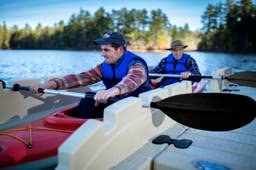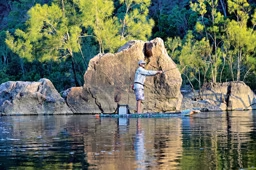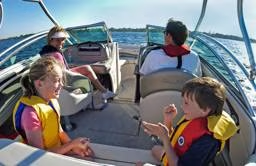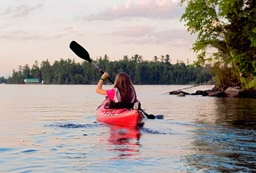
Spending an early morning or an afternoon on the water is the highlight of my day. In the morning, the water is flat, mist rises off the glassy surface of Lake Champlain and cormorants silently dive for their breakfast. I hear the occasional cry of a gull overhead or the splash of a fish – and pretty much nothing else but the plink of water droplets from my paddle hitting the quiet lake surface, as I glide silently forward and dip my blade in for another stroke.
More and more people are paddling in their free time, partly because kayaks are becoming more comfortable, more stable and more tailored to paddlers’ needs.
See also Lessons in Stand-Up Paddleboarding
Stability-Plus
In the past, paddlers had to choose either a stable boat or a performance boat. Now you can get both qualities in one kayak. Long known for high primary stability (feels stable when you get in and out) are recreational or “rec” boats. These kayaks are made for lolling around the lake, river or pond in front of your cabin. But they’ve been notoriously slow, hard to control and feature free. No more.The newest crop of rec kayaks are just as stable as the old guard, but manufacturers have revisited, rethought and revised hull shapes and are now designing rec boats that stay on track, paddle easily and slice through the water without threat of dumping you in the drink.
“We’re listening to the feedback we’re getting from paddlers,“ said Sara Knies, Director of Marketing for Johnson Outdoors Paddlesports. “Across the board, paddlers want more stability and more performance at a lighter weight.”
New ultralight rec boats are light enough that one person can lift the boat onto the roof of his or her car. Traditionally, rec boats have had heavy plastic hulls and weighed in at almost 50 pounds. Now, some check in at under 40 pounds.
And recreational day-touring boats are gaining traction. They’re sea-worthy in bigger, rougher waters,can hold enough gear for an overnight if you’re feeling adventurous, and they’re easy to paddle.
“If you bought a 16-foot boat five years ago for performance, now you can trade it in for a 12-foot boat or a fourteener that will give you the same paddling performance at lower weight with a more comfortable seat,” said Knies.
Seated in Comfort
The biggest advance in paddlesports for the coming season is in your seat. Sitting in a kayak, whether for an hour or for an entire day, can put a lot of pressure on your back if you’re not supported well.More padding and better lumbar support are the answer. New seats have both, as well as increased seat adjustability. You’ll also find higher seat backs and remolded seat pans (the part you sit on) – putting your body in a more comfortable and more efficient position for paddling.
In some fishing kayaks, seats are designed to let you sit sideways to dangle your feet into the water. Some companies also sell aftermarket seats or seat accessories so you can further customize your ride once you’ve logged some paddling time and have a better idea of what needs tweaking.
Made for Women
For women, fit is not just about seat ergonomics. Women often have a shorter reach than men, so new women’s kayaks have reconfigured cockpits that let those with shorter reach get their paddles into the water without needing yoga moves to reach over the gunwales. Kayaks for smaller paddlers are becoming more popular, and boats are being built that are light and maneuverable.Even carrying handles are being repositioned to make kayak carrying more comfortable for all.
Regional Design
“Paddlers want a boat that works in their environment, so we’re designing hulls for different geographic regions,” said Buff Grubb, Brand Manager for Mad River Canoe and Accessories at Confluence Watersports. “On the West Coast, paddlers need more buoyancy and drier ends, so they can punch through surf off the beach to get to the fishing areas where they want to anchor. In rivers and lakes with no surf, like in the Central U.S., narrow boats that travel fast might make a better choice.”

New ultralight recreational kayaks, like this 37-pound Necky Manitou are light enough for a single person to lift and carry.
Ready for Fishing Too
As more anglers use a stealthy kayak to sneak up on their catch, kayak builders are tricking out boats with rod storage, transducer mounts and glove boxes to hold fish finders. Battery bags hold fish finder batteries out of the water and out of the way.
See also In Search of Lurking Lunkers
A wealth of in-molded or addon accessories, from cup holders to between-the-leg hatches that can be accessed on-water, are debuting in boats from rec to touring.
Coolness Factor Companies also are considering aesthetics when designing boats. “Paddlers want something that looks cool on the roof of their car or in front of their cabin,” said Knies. “So we’re adding more molded features, reflective deck rigging and elements like colored recessed fittings that make a kayak feel a little more modern, a little more personal and add a little flair.”
Whatever your choice in a new boat, whenever you can, try before you buy. Sitting in a kayak on the showroom floor is second best. Finding the boat, and the rest of the package, that fits your body and your needs will guarantee that you enjoy many peaceful mornings on the water.
Writer and photographer Berne Broudy has paddled lakes and rivers at home in Vermont, near her family cabin in New York’s Thousand Islands and in exotic destinations including Chile and Mongolia.










